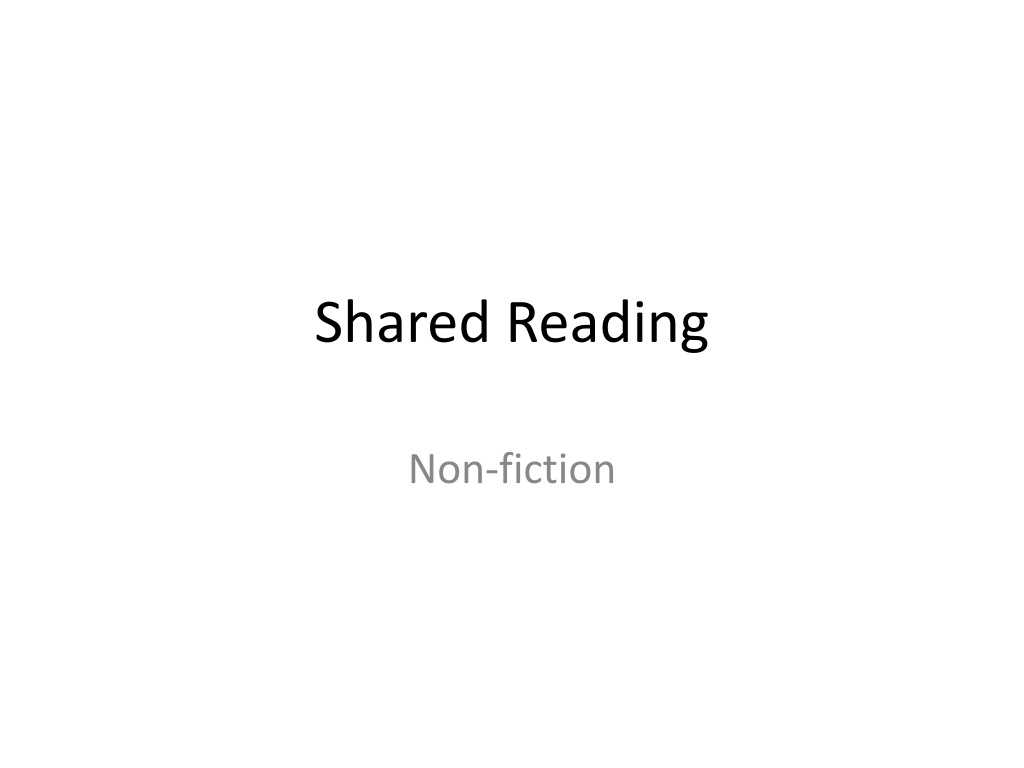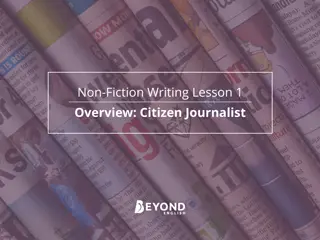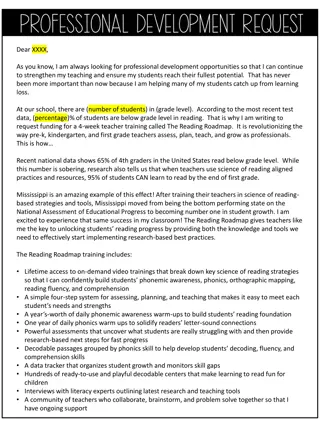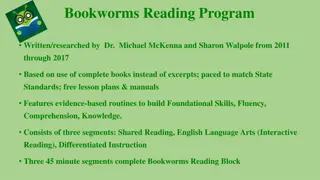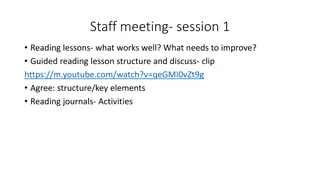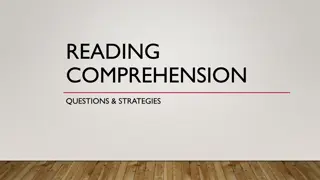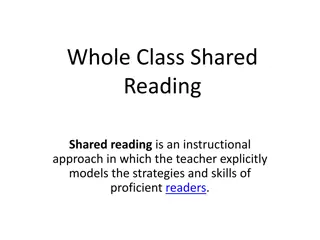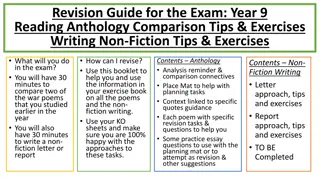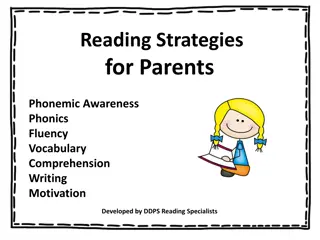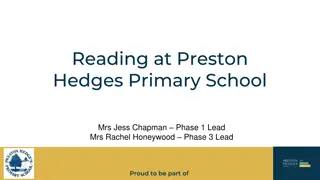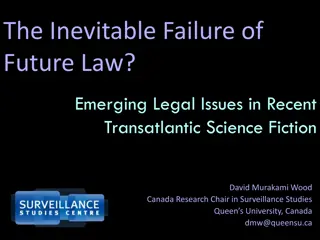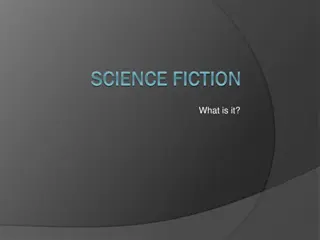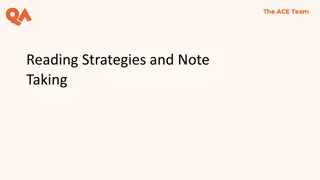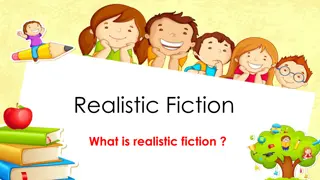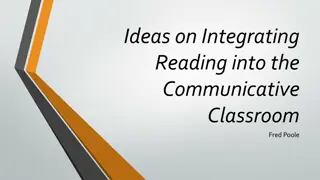Effective Strategies for Shared Reading in Non-Fiction Settings
Shared reading in non-fiction is an effective approach to reinforce literacy skills while teaching subject-specific content. Teachers choose texts that match students' reading levels, are cross-curricular, and engaging. Discussions, predictions, vocabulary exploration, and historical context are integral parts of the shared reading process. Through this collaborative reading experience, students enhance their reading abilities and content knowledge.
Download Presentation

Please find below an Image/Link to download the presentation.
The content on the website is provided AS IS for your information and personal use only. It may not be sold, licensed, or shared on other websites without obtaining consent from the author. Download presentation by click this link. If you encounter any issues during the download, it is possible that the publisher has removed the file from their server.
E N D
Presentation Transcript
Shared Reading Non-fiction
Shared Reading Shared reading is an ideal way to work through subject areas which deal with factual text. It helps literacy to be taught and reinforced whilst teaching the subject lesson. It also helps to support struggling readers by helping them to engage with text in a supported way enabling them to be more independent with that text later on.
When selecting texts for reading, teachers typically look for text that is appropriate for the reading level of the students, that is also cross- curricular and relevant in its nature. The text should be of an appropriate length for study and be adequately complex. The text should also have an impact.
Introducing the text Talk about clues found from Title, author, source, illustrations and what we already know about the subject. Group discussions can take place with one person appointed as scribe and one as the reporter.
Blue Pages The blue pages on this PPt are examples of ones which you could use with your pupils. Using the next slide, you would ask pupils individually or in groups to predict what the text will be about, what information they may find and what they already know about the topic.
Time Snapshots through History
First Reading Read over the text explaining vocabulary which may not be known asking pupils for their ideas as well asking for their ideas and understanding from the context. It is useful to highlight target vocabulary. This can then be used as part of the assessment or activity later and will provide pupils with necessary spellings.
The Sun The first people to live on Earth probably used the position of the sun to work out what time of day it was. Their life would be governed by where the sun was in the sky. If the sun was on the horizon then it must be the beginning or the end of the day. If the sun was high overhead, then it was about mid-day. It is dangerous to look at the sun without shielding your eyes, and many people would have hurt their eyes looking at the sun. There were two main problems in telling the time this way. The first was that it was impossible to tell the exact time. If you arranged to meet someone in a field in the morning to go hunting, you could have a very long wait until he arrived. The second problem was that the sun isn t always visible. When it was a cloudy day, you would not have seen the position of the sun in the sky. It was also impossible to tell the time at night. Over the millions of years since the first man walked on Earth, many changes have taken place in the way that we tell the time. In the next few lessons we are going to study a brief history of time.
Literacy Focus The long /E/ sound. Share the focus with the pupils. As you read the text again, ask the pupils to shout out when you read a word with the long /e/ sound. Make sure they know the difference between long /e/ and short /e/ sound. Place the words with long /e/ into columns showing the different ways of writing long /e/.
The Sun The first people to live on Earth probably used the position of the sun to work out what time of day it was. Their life would be governed by where the sun was in the sky. If the sun was on the horizon then it must be the beginning or the end of the day. If the sun was high overhead, then it was about mid-day. It is dangerous to look at the sun without shielding your eyes, and many people would have hurt their eyes looking at the sun. There were two main problems in telling the time this way. The first was that it was impossible to tell the exact time. If you arranged to meet someone in a field in the morning to go hunting, you could have a very long wait until he arrived. The second problem was that the sun isn t always visible. When it was a cloudy day, you would not have seen the position of the sun in the sky. It was also impossible to tell the time at night. Over the millions of years since the first man walked on Earth, many changes have taken place in the way that we tell the time. In the next few lessons we are going to study a brief history of time.
Sorting the long /e/ words e ee ea ie eo Other?
Cloze Procedure Use a condensed version of your text with core words missing. These could be the words which were highlighted in the first text. For some pupils, you could let them have the missing words, with others, they should try to remember the words without having the missing words. Give the pupils a copy of the cloze procedure to work on in groups. Next, groups feed back their choice of words. Groups check and change and mistakes. If a child has used a synonym of the correct word then that is good. You could take some time to discuss other possible words with the same meaning.
The Sun The first people to live on Earth probably used the ________of the sun to work out what time of day it was. Their life would be _________by where the sun was in the sky. If the sun was on the ________then it must be the beginning or the end of the day. If the sun was high overhead, then it was about________. It is dangerous to look at the sun without ___________your eyes, and many people would have hurt their eyes looking at the sun. There were two _________problems in telling the time this way. The first was that it was impossible to tell the ________time. If you __________to meet someone in a field in the morning to go hunting, you could have a very long wait until he arrived. The second problem was that the sun isn t always_________. When it was a cloudy day, you would not have seen the position of the sun in the sky. It was also _________to tell the time at night. position main shielding arranged mid-day impossible horizon visible governed exact
Comprehension Strategy Focus Summarising As we read, take a note of the main points. Use single word, phrases or quick drawings when note taking. The teacher or a proficient pupil could produce a graphic organiser or mind map during the reading and subsequent discussion. This helps pupils to write a good summary without the temptation to plagiarise the text.
The Sun The first people to live on Earth probably used the position of the sun to work out what time of day it was. Their life would be governed by where the sun was in the sky. If the sun was on the horizon then it must be the beginning or the end of the day. If the sun was high overhead, then it was about mid-day. It is dangerous to look at the sun without shielding your eyes, and many people would have hurt their eyes looking at the sun. There were two main problems in telling the time this way. The first was that it was impossible to tell the exact time. If you arranged to meet someone in a field in the morning to go hunting, you could have a very long wait until he arrived. The second problem was that the sun isn t always visible. When it was a cloudy day, you would not have seen the position of the sun in the sky. It was also impossible to tell the time at night. Over the millions of years since the first man walked on Earth, many changes have taken place in the way that we tell the time. In the next few lessons we are going to study a brief history of time.
Preview If the text is part of a series, then you could read over the text which will be focussed on next session. This sets the scene and give the pupil s time to notice and be aware of related materials during the coming days.
Sundials In about 3500 B.C. the Ancient Egyptians conceived a plan for telling the time. They put up large standing stones called obelisks. These huge pillars cast shadows on the ground depending on the time of day it was. The shadow moved around the pillar as the sun moved through the sky. They received the information by looking at where the shadow was on the ground. This was better than just looking at the sun. Looking at shadows on the ground did not hurt their eyes the way looking directly at the sun did. By 1500 B.C. smaller sundials had been invented. Around the sundial, marks were made, so that the sun cast the same shadow on these marks at about the same time every day. It became easier to arrive at a meeting place at almost the same time as the person you were meeting. But the sun still often deceived them. There was still the problem that the sundials couldn t work when it was cloudy, or at night.
The Sun The first people to live on Earth probably used the ________of the sun to work out what time of day it was. Their life would be _________by where the sun was in the sky. If the sun was on the ________then it must be the beginning or the end of the day. If the sun was high overhead, then it was about________. It is dangerous to look at the sun without ___________your eyes, and many people would have hurt their eyes looking at the sun. There were two _________problems in telling the time this way. The first was that it was impossible to tell the ________time. If you __________to meet someone in a field in the morning to go hunting, you could have a very long wait until he arrived. The second problem was that the sun isn t always_________. When it was a cloudy day, you would not have seen the position of the sun in the sky. It was also _________to tell the time at night. position main shielding arranged mid-day impossible horizon visible governed exact
Hour Glasses In about 3450 B.C. a new way of time keeping was invented. It was a simple form of the hour glass or egg timer. It started out as a bowl with a small hole in the bottom. Water dripped through the hole slowlyas the day wore on. Grooves cut in the side of the bowl, measured approximately the passage of time. One advantage of the water timer was that it wasn t dependent on the sun, but it did have some problems. One problem was making sure that each water timer was the same. If the hole was bigger or smaller, then the water would flow faster or slower. If too much water was put in, then it would last longer and it would appear that there was more time in the day. The other problem was that the water would freeze in the winter. 2000 years later a glass sand timer was invented. Like the water timer, it could work at night, but because sand was so heavy, they could only use small amounts of sand. This meant that it could work only for short periods of time.
Mechanical Clocks Telling the time accurately improved a lot in the 1300 s when mechanical clocks which used weights or springs began to be made. To start with, these clocks had only one hand. Later a minute hand was added. The clock was powered by weights or springs. In the 1400 s the coiled spring was invented. This was able to move the hands on the clocks. It also meant that it was possible to make smaller clocks. These clocks worked quite accurately. They only lost about 15 minutes in the day. Pendulum clocks were developed next. They used swinging weights to keep the hands moving constantly. These were ever more accurate, losing less than a minute a day. The bigger the pendulum was, the more accurate the clock. Grandfather clocks were very popular and some of these old ones are still working today. One group of people who found these clocks difficult to use were sailors. Clock makers had to work on developing smaller and more accurate clocks for ships.
Greenwich Mean Time Clocks had made a big difference to people s lives. No longer were people just making arrangements with friends to go hunting. Businesses employing hundreds of people wanted everyone to start work at the same time and countries far apart wanted to do business together. This meant that it was important that time ran at the same time everywhere. Great Britain invented Greenwich Mean Time . Greenwich is the name of a town in England. The whole world agreed on times which matched up with the Greenwich Mean Time. Because the sun does not reach everywhere in the world at the same time, imaginary lines were drawn around the world from the North Pole to the South Pole. This was used to divide the world up into time zones. There is 15 minutes between each time zone. People who live in some parts of Hawaii are 10 hours behind us. People living in Japan are 9 hours ahead of us.
Watches When wristwatches were first made, only women wore them. Men wore pocket watches. These were kept in a pocket and fastened to a button by a chain. During the First World War, soldiers started wearing wristwatches instead of pocket watches because it was not convenient to keep taking pocket watches out in the middle of a battle. The next biggest invention was the digital watch. Instead of having a clock face and hands, the digital watch had a screen on which numbers flashed. Digital watches can be very accurate. Some watches even have their time set by satellites which orbit the Earth. Many changes and developments have taken place since mankind first walked on Earth. The development of measuring time accurately must be one of the most important developments. Can you imagine today s life without clocks and watches?
